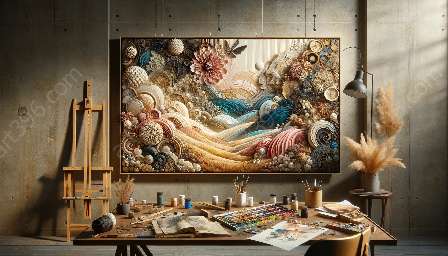Public spaces have become a canvas for artistic expressions, and mixed media installation art has played a pivotal role in reshaping these environments. This article focuses on exploring the intriguing intersection between public spaces and mixed media installation art, providing a thorough understanding of how these forms of art complement each other and contribute to the cultural fabric of our communities.
The Rise of Mixed Media Art in Public Spaces
Mixed media art encompasses diverse materials and techniques, offering endless possibilities for creative expression. When brought into the public sphere, these artworks have the potential to engage and inspire diverse audiences. Whether it's a bustling city square, a tranquil park, or an abandoned industrial site, mixed media installations can breathe new life into these spaces, sparking conversations and forging connections.
Engaging the Senses
One of the defining features of mixed media installation art is its ability to engage multiple senses. Through the combination of visual, auditory, and tactile elements, these installations create immersive experiences that captivate viewers and encourage interactive participation. The juxtaposition of different materials and textures adds depth and complexity to the artwork, inviting observers to explore and interpret the piece from various perspectives.
Embracing Diversity and Inclusivity
Public spaces serve as gathering points for diverse communities, and mixed media installation art has the power to reflect and celebrate this diversity. Artists often incorporate cultural symbols, historical references, and social commentary into their works, fostering a sense of inclusivity and inviting dialogue on pertinent issues. By occupying public spaces, these artworks become accessible to people from all walks of life, fostering a shared experience that transcends societal boundaries.
Transforming Urban Landscapes
Mixed media installation art has the capacity to transform urban landscapes into dynamic, thought-provoking environments. By reimagining abandoned lots, underutilized buildings, and neglected corners, artists can invigorate these spaces with thoughtfully crafted installations. These interventions not only add aesthetic value but also prompt reevaluation of how we perceive and interact with our surroundings, contributing to the revitalization of urban areas.
Interactive and Participatory Art
Many mixed media installations in public spaces are designed to be interactive, encouraging viewers to become active participants in the artistic process. Whether through kinetic sculptures, projection mapping, or sensory installations, these artworks blur the line between creator and audience, inviting individuals to co-create and influence the unfolding narrative. This participatory element fosters a sense of ownership and connection, as viewers form personal connections with the art and the spaces it inhabits.
Challenges and Opportunities
While mixed media installation art in public spaces offers numerous benefits, it also presents challenges such as logistical considerations, maintenance, and public perception. However, these challenges are accompanied by exciting opportunities to collaborate with urban planners, community organizations, and local governments to integrate art into urban infrastructure and public programming. By addressing these complex dynamics, artists and stakeholders can work together to realize the full potential of mixed media installation art in public spaces.
Conclusion
Mixed media installation art has emerged as a compelling force in transforming public spaces into vibrant hubs of cultural expression and communal interaction. Through its ability to engage the senses, embrace diversity, and reshape urban landscapes, this form of art enriches our collective experience and fosters a sense of shared ownership in the places we inhabit. By exploring the synergy between mixed media art and public spaces, we gain valuable insights into the evolving relationship between art, society, and the urban environment.

